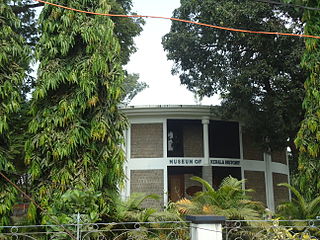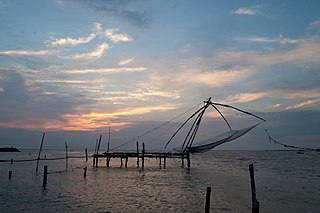Related Research Articles

Kochi, also known by its former name Cochin, is a major port city along the Malabar Coast of India bordering the Laccadive Sea. It is part of the district of Ernakulam in the state of Kerala. The city is also commonly referred to as Ernakulam. As of 2011, the Kochi Municipal Corporation had a population of 677,381 over an area of 94.88 km2, and the larger Kochi urban agglomeration had over 2.1 million inhabitants within an area of 440 km2, making it the largest and the most populous metropolitan area in Kerala. Kochi city is also part of the Greater Cochin development region and is classified as a Tier-II city by the Government of India. The civic body that governs the city is the Kochi Municipal Corporation, which was constituted in the year 1967, and the statutory bodies that oversee its development are the Greater Cochin Development Authority (GCDA) and the Goshree Islands Development Authority (GIDA).

The Kingdom of Travancore, also known as the Kingdom of Thiruvithamkoor or later as Travancore State, was kingdom that lasted from c. 1729 until 1949. It was ruled by the Travancore Royal Family from Padmanabhapuram, and later Thiruvananthapuram. At its zenith, the kingdom covered most of the south of modern-day Kerala and the southernmost part of modern-day Tamil Nadu with the Thachudaya Kaimal's enclave of Irinjalakuda Koodalmanikyam temple in the neighbouring Kingdom of Cochin. However Tangasseri area of Kollam city and Anchuthengu near Attingal in Thiruvananthapuram were parts of British India.

Chendamangalam is a small town and a panchayat in Paravur Taluk, Ernakulam district in the state of Kerala, India.

Ernakulam is one of the 14 districts in the Indian state of Kerala, and takes its name from the eponymous city division in Kochi. It is situated in the central part of the state, spans an area of about 2,924 square kilometres (1,129 sq mi), and is home to over 9% of Kerala's population. Its headquarters are located at Kakkanad. The district includes Kochi, also known as the commercial capital of Kerala, which is famous for its ancient churches, Hindu temples, synagogues and mosques.

The Kingdom of Cochin or the Cochin State, named after its capital in the city of Kochi (Cochin), was a kingdom in the central part of present-day Kerala state. It originated in the early part of the 12th century and continued to rule until its accession to the Dominion of India in 1949.
Paliath Achan or Paliyath Achan is the name given to the male members of the Paliam family, a Nair/Menon royal family from the Indian state of Kerala who ruled over Chendamangalam, Vypin, parts of Thrissur and regions that were under the erstwhile Kingdom of Villarvattom. The family had palaces and forts in these regions but their primary residence remained in Chendamangalam. The Paliath Achans were given the role of hereditary Prime ministership of the Kingdom of Cochin by the Kochi Maharajah.

Thrippunithura, also spelled Tripunithura,, is a municipality in the Ernakulam district of Kerala, India. It is part of the Kochi metropolitan area, 7 km (4.3 mi) east of the Kochi city centre. As per the 2011 Indian census, Thrippunithura has a population of 69,390. A prominent historical region, Thrippunithura was the capital of the erstwhile Kingdom of Cochin. The Hill Palace situated in Thripunithura was the palace of Maharaja of Cochin, the ruler of Kingdom of Cochin. Thrippunithura is known for its rich culture which includes the annual Vrishchikotsavam festival that takes place at the Sree Poornathrayeesa Temple.

Rama Varma Kunji Pillai Thampuran (1751–1805), or Rama Varma IX, popularly known as Sakthan Thampuran, was the ruler of the Kingdom of Cochin. The current southern Indian city of Kochi was part of the erstwhile princely state of Kochi. He resided at Vadakkechira Palace in Thrissur. The city of Thrissur is referred to as the Cultural Capital of Kerala owing to its many traditional festivals and historic temples. Sakthan Thampuran is considered the architect of the city of Thrissur. The festival Thrissur Pooram was started by him.
Menon is an aristocratic hereditary title of the Nair community bestowed by various kings of Kerala, most saliently the Zamorin of Calicut and Maharaja of Cochin, upon eminent Nairs. The recipient of the title held it lifelong, and the male members of the family held it in perpetuity in the matrilineal line.

Edappally is a ward of Kochi, Kerala. The name is also used to refer to adjacent wards of Kalamassery and Thrikkakkara municipalities. Edappally is a major commercial centre as well as a prominent residential region. Edappally junction is one of the busiest junctions in the city.

Fort Kochi, formerly known as Fort Cochin or British Cochin, is a neighbourhood of Kochi city in Kerala, India. Fort Kochi takes its name from the Fort Manuel of Kochi, the first European fort on Indian soil, controlled by the Portuguese East Indies. This is part of a handful of water-bound islands and islets toward the south-west of the mainland Kochi, and collectively known as Old Kochi or West Kochi. Adjacent to this is the locality of Mattancherry. In 1967, these three municipalities along with a few adjoining areas, were amalgamated to form the Kochi Municipal Corporation.

Thiruvankulam is a census town in Thrippunithura municipality, in Ernakulam district, Kerala, India. The area is a part of the Kochi metropolitan area. NH 85 passes through Thiruvankulam. The Karingachira junction is the location of the southern terminus of the Seaport-Airport Road, which connects the Cochin International Airport and the Cochin Port.

The Kochi metropolitan area or Kochi urban agglomeration is a metropolitan area consisting of Kochi and its satellite towns in Ernakulam district, Kerala, India. With a population of more than 2.1 million within an area of 440 km2, it is the most populous metropolitan area in Kerala.
Jenmi or Janmi, plural Jenmimar, is the Malayalam term used to refer to the landed aristocracy of Kerala who traditionally held their lands as absolute and allodial owners, with such lands known as Jenmom or Janmam. They formed the landowning nobility as well as the landed gentry of the region in colonial times, and the majority of the estates and feudal properties were owned by this community. They predominantly belonged to the Nambudiri and Nair castes.
Paravur Taluk, IPA:[pɐrɐʋuːr], is a taluk of Ernakulam District in the Indian State of Kerala. North Paravur is the capital of the taluk. Paravur Taluk lies in the north western part of Ernakulam district bordering Thrissur district. The surrounding taluks are Kochi to the west consisting of Vypin Island, Kodungallur to the north, Chalakudy to the north consisting of Mala, Aluva to the east consisting of Angamaly, Nedumbassery and Aluva, Kanayanur to the south consisting of Cochin City. Paravur is a part of Kochi urban agglomeration area. The western parts of taluk are coastal areas with cultivations like prawn and pokkali rice. The eastern parts are fertile lands. The heavy industries of Kochi is located in Udyogmandal area of the taluk.

Hill Palace is an archaeological museum and palace located in the Tripunithura neighbourhood of Kochi, Kerala. It is the largest archeological museum in the state and was the imperial administrative office and official residence of the Cochin Maharaja. Built in 1865, the palace complex consists of 49 buildings spreading across 54 acres (220,000 m2) and built in the traditional architectural style. The complex has an archaeological museum, a heritage museum, a deer park, a pre-historic park and a children's park.

Kerala sari (Set-sari) is a clothing of women in the Indian state of Kerala.
Kodungallur Kovilakam, is a palace of the royal family of the late [medieval] Kingdom of Kodungallur (Cranganore), in the modern-day Indian state of Kerala. Kodungallur was a feudal principality subordinate to the rulers of the Kingdom of Cochin from the later half of the eighteenth century until Indian independence. The Kingdom of Kodungallur was under the protection of the Dutch government after 1707 for a few years before returning to its allegiance to the Zamorin. The Kodungallur Royal Family had two branches, at Chirakkal Kovilakam and Puthen Kovilakam.

N. K. Jose was an Indian historian who was President of the Kerala History Congress known for his studies in Dalit and Christian history in Kerala. Author of over 140 history and social history books, he was given the title Dalit Bandhu by Dalit organizations in 1990 in recognition of his contributions to Dalit studies and Dalit history.
References
- ↑ "MGU Library catalog › Details for: PALIYAM SATYAGRAHA: A STRUGGLE FOR PUBLIC DOMAIN". MGU Library catalog. Retrieved 13 October 2022.
- ↑ "പാലിയം വിളംബരം അടയാളപ്പെടുത്തുന്നത്". Janmabhumi. 13 October 2022. Retrieved 13 October 2022.
- ↑ പയ്യപ്പിള്ളി, ബാലൻ (2011). പാലിയം സമരം. ചിന്ത പബ്ലിഷേഴ്സ്. ISBN 978-81-262-0709-1.
- ↑ "'Ultimate power of love': Malayalam poet Akkitham Achuthan Namboodiri passes away at 94". The New Indian Express. 15 October 2020. Retrieved 13 October 2022.
- ↑ രവീന്ദ്രൻ, മിൽജിത് (21 October 2018). "അവർണന്റെ മാനത്തിനുവേണ്ടി ചോരചിന്തിയ പാലിയം സമരം - Special - Sunday Oct 21, 2018". Deshabhimani (in Malayalam). Retrieved 13 October 2022.